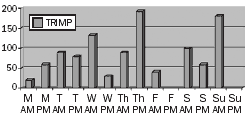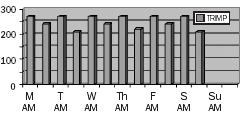A training schedule, variation, progression and recovery will be planned within or between weekly programs to maximize the fitness effect. For example, an endurance coach will plan how best to organize five sessions at steady pace, three interval sessions at high intensity, one complete rest day, three runs at threshold pace and one conditioning session to make the best training week. No doubt PP readers are familiar with this system of planning and training schedules organization.
Athletes (most of them at least) use diaries to record their training. Commonly, these diary entries will contain session details for each day and may include comments.
For example, Tuesday am - 30 minute run steady. Felt good. Tuesday pm - 8 x 800m, 2 mins rest. Average time 2min 40s. Legs felt crap.
By contrast with the rigorous planning of their coaches, athletes' recording of training is often subjective, lacking in particular any information that can be used to calculate the training load of the session. The coach will have planned exactly when the hard, moderate and easy training sessions should take place, yet the athlete does not record information that can be used to determine whether this, in fact, occurred.
Perceptions of the level of training may also differ between coach and athlete. For example, an athlete may find a 'circuits' session hard, but the coach may assume that it is moderate and place it in the weekly plan accordingly. The resulting weekly program may therefore lack the recovery element needed to maximize fitness benefits.
In order to help coaches and athletes plan and then monitor the effects of training more precisely, physiologists have attempted to devise quantifiable methods for recording training load. These methods enable athletes to record training load in terms of numbers, thus making sessions objectively comparable.
Training load may be defined as the stress placed upon the body as a result of the training session. It has both a fitness and fatigue effect (1), but in order for training schedules to result in improved fitness, the former must outweigh the latter. If the training load is too heavy or too monotonous, the athlete will not experience optimal improvement.
In this article I will describe three different methods of quantifying a training load, each with its own merits and limitations. I will also demonstrate the potential usefulness of Excel spreadsheets in helping coaches and athletes summarize their training loads in graphic terms.

First Method
The Basic TRIMP Method
First proposed by Bannister et al in 1975, this method is a very simple way of calculating what is termed TRaining IMPulse (TRIMP). TRIMP is defined as training volume x training intensity and is specific to endurance training as it uses heart rates or heart rate zones. Initially the researchers proposed simple methods of calculating the TRIMP of a session, such as the following:

1. Calculate Your Approximate Heart Rate:
(If you already know just skip to the next calculator)

|
 |
||
 |
|||

2. Calculate Your TRIMP:
(Use the calculator above to get your heart rate, then enter it in the box below)

TRIMP = training time (minutes) x average heart rate (bpm). For example, 30 minutes at 145 bpm. TRIMP = 30 x 145 = 4350.
|
|
 |
||
 |
|||
This method, involving simple math, makes a great deal of sense in terms of calculating a 'dose' of aerobic training, and I would recommend it to the average adult exerciser. For adults looking to improve basic cardiovascular fitness by means of simple training sessions, such as continuous pedaling on an indoor bike, or an aerobics class, this calculation gives them a great monitoring tool to analyze their progress and adherence to training.
A week's training schedule could be tabulated and calculated in Excel, as shown in table 1 below. Weekly TRIMP totals could be used as targets for general CV fitness goals or to encourage increased activity.
 Table 1: Table 1: A Week's Training Using The TRIMP Method A Week's Training Using The TRIMP Method |
||||||||||||||||||||
|
||||||||||||||||||||
The disadvantage of this system is that it does not distinguish between different levels of training, which would be a problem for a more advanced exerciser or elite athlete. For example, 30 minutes at 145 bpm gives a TRIMP score of approximately 4,500, as does 25 minutes at 180 bpm, although clearly these are very different levels of training. Assuming a max heart rate (HR) of 185 bpm, this means that one session takes place at 78% of max HR and the other at 97%. The latter will be very demanding, involving high lactate levels and a greater training load than the former.

Second Method
TRIMP Training Zone Method
To overcome this limitation, subsequent researchers refined the basic TRIMP concept, using heart rate zones to weight intensity in the calculation 2. Foster et al split intensity into five zones, as follows3:
- 50-60% max HR
- 60-70%
- 70-80%
- 80-90%
- 90-100%
The zone number is used to quantify training intensity; TRIMP is calculated as the cumulative total of time spent in each training zone. To express a similar example to that above in these terms:
- 30 minutes at 140 bpm. Max HR = 185 bpm. %max HR = 140/185 x 100 = 76%. Therefore, training intensity = 3. TRIMP = training volume (time) x training intensity (HR zone). 30 x 3 = 90.
- 25 minutes at 180 bpm. Max HR = 185 bpm. %max HR = 97%. Training intensity = 5. TRIMP = 25 x 5 = 125.
As you can see, this method finds that 25 minutes of working at a very high heart rate results in a higher training load score than 30 minutes at a steady state heart rate.
The zone TRIMP calculation method can distinguish between training levels while remaining mathematically simple and I would recommend its use to serious exercisers and elite endurance athletes, especially as it can be used for quantifying interval sessions with variable heart rates. To calculate the TRIMP for the interval session, simply add up the time spent in each zone, as in the following example:
- 5 x 3 minutes at 95% max HR with 3 minutes easy jog at 70% max HR recovery. TRIMP = 15 x 5 + 15 x 2 = 105.
The table and accompanying bar chart below describe a hypothetical example of a week's training schedule for an elite runner, using Excel to calculate and plot TRIMP across the week. Tuesday and Thursday are interval sessions. For example, 8 x 2min 30s reps in zone 5, with 2min recovery in zone 2.
 Table 2: Table 2: A Week's Training For An Elite Runner Using TRIMP Training Zone A Week's Training For An Elite Runner Using TRIMP Training Zone |
||||||||||||||||||||||||||||||||||||||||||||||||||||||||
|
||||||||||||||||||||||||||||||||||||||||||||||||||||||||

The graph shows quite clearly where the peaks in training load occur during the week, and it would seem that this hypothetical schedule spreads the training load sensibly, including days of relative rest between the hard sessions.
The limitation of the TRIMP heart rate zone method is that it can only quantify aerobic training. Strength, speed, anaerobic and technical sessions, which do not involve high heart rates but are nonetheless intense, cannot be calculated accurately by these means. Thus the method is suitable only for evaluating endurance training.

Session RPE Method
Foster et al developed a method of evaluating training using a variation of the Borg Rating of Perceived Exertion (RPE) scale (see table 3 below), which is designed to measure subjective perception of effort(3).
To calculate the TRIMP, the time of the session (in minutes) is multiplied by the RPE scored. For example, for 60 minutes of weight training, rated as very hard (RPE = 7), TRIMP = 60 x 7 = 420.
(Note, however, that it is not advisable to compare TRIMP scores calculated by different methods. The scores are arbitrary and comparisons are useful only within the same method.)
 Table 3: Table 3: The Borg Rating Of Perceived Exertion Scale The Borg Rating Of Perceived Exertion Scale |
||||||||||||||||||||||||||||
|
||||||||||||||||||||||||||||
Foster and his team studied the reliability of this TRIMP method, asking subjects to rate various types of aerobic training sessions performed on a bike, 30 minutes after the session had finished(3). They claim that, while this use of the RPE scale is unconventional, it is not influenced by momentary changes in intensity, which are proven to influence ratings.
The subject provides a 'global' rating of the session, known as 'session RPE', which allows for better comparisons between different types of training, especially sessions that are not dependent upon heart rate.
Foster's study showed that session RPE was a more reliable indicator than heart rate data for evaluating the intensity of endurance training. And, more recently, other researchers have confirmed its reliability for evaluating the intensity of strength training (4).
For example, a session of strength exercises involving sets of 4 reps at 90% of rep max was rated higher than a session involving sets of 15 reps at 50% of rep max (rep max being the highest weight possible for that exercise and defined as 100% intensity for strength training).
The session RPE TRIMP method is very useful for athletes in sports that involve a variety of training modes, especially anaerobic and technical training, e.g. ball games and power sports. Athletes in these sports may train for long periods of time, and while their average heart rate for the session may be low, indicating a light aerobic training load, the overall training load on the body (including anaerobic and neuromuscular work) will be significant and needs to be calculated.
The hypothetical example of a boxer's training schedule, set out in table 3 and the accompanying bar chart below, illustrates the power of the session RPE TRIMP method, which can also be calculated and plotted in Excel.
Here we can see how the session RPE method can be used to quantify the training load across different types of training. This makes it a very powerful monitoring tool for many different sports. This hypothetical example shows that, while the Tuesday evening sparring and circuits session looks the most demanding of the week, in fact the athlete perceived Monday evening's 90- minute technical session as more demanding.
 Table 4: Table 4: A Week's Training For A Boxer Using The Session RPE TRIMP Method A Week's Training For A Boxer Using The Session RPE TRIMP Method |
||||||||||||||||||||||||||||||||||||||||||||||||||||||||
|
||||||||||||||||||||||||||||||||||||||||||||||||||||||||
This is a useful illustration of how ratings of training load can correct mismatches between what the coach thinks of as hard training and what the athlete actually experiences. Evaluation based on 'actual' rather than planned training will be important for many athletes striving to achieve their best.
The table and bar chart below and right give a second example of the use of the session RPE method, using a hypothetical tennis training schedule. This illustrates how Session RPE TRIMP can point to monotony in training routines, since the TRIMP plot in the bar chart shows very similar values for all sessions. In the light of this data, coach and athlete could easily make adjustments to either the length or intensity of training sessions to allow for more variation in the weekly training schedule.
 Table 4: Table 4: A Week's Training For A Tennis Player Using Session RPE A Week's Training For A Tennis Player Using Session RPE |
||||||||||||||||||||||||||||||||||||||||||||||||||||||||
|
||||||||||||||||||||||||||||||||||||||||||||||||||||||||


In Summary
I have presented three methods for evaluating training load objectively. The first and most simple - basic TRIMP method - is probably best suited to those training for general health benefits and unable to account for training intensity in training load.
The second - heart rate zone TRIMP method - is a simple tool for monitoring all aerobic training and is excellent for endurance athletes. The final method - session RPE - is perhaps the most versatile since it can be use to rate the load of any kind of training. It is perfect for games players, power and technical sport athletes.
Raphael Brandon
References
- Aust J Sports Med, 1975, 7: 57- 61
- J Appl Physiol, 1990, 69(3): 1171- 77
- J S&C Res, 2001, 15(1): 109-115
- J S&C Res, 2004, 18(4): 796-802



